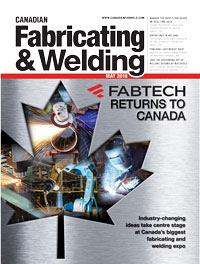Editor
- FMA
- The Fabricator
- FABTECH
- Canadian Metalworking
Material handling key for fibre laser success at RB Millwork
Manitoba fab shop keeps growing its capabilities with critical customers in mind
- By Rob Colman
- May 29, 2018
- Article
- Automation and Software
Miami, Manitoba-based RB Millwork is a family-run business that has been in operation for about 10 years. The trajectory of the shop’s growth is a prime example of how family businesses have to change and adapt quickly to maintain customers. This particular company has four primary customers that it always keeps in mind as it considers new investments.
Growth With a Purpose
As the shop’s website says, RB Millwork “will do whatever it takes to ensure you are happy with the work we have done, that you feel like you are getting fair pricing, and that you will be welcomed warmly.” With respect to quality, the team listens to what their customers believe the shop needs for equipment, and RB invests accordingly.
As General Manager Fred Waldner explained, the shop started out with a shear and an old press brake. But to grow the business, it was understood that they would have to expand their capabilities. In 2012 they invested in a Bystronic ByJet Smart waterjet cutting system, on which the shop cuts mild steel up to 2 in. thick. Shortly thereafter the shop invested in a 4-kW CO2 laser and a new Xpert 100 press brake. Add to that a Davi plate roller and you’ve got a shop ready to tackle any job.
And indeed, RB Millwork has been a part of many projects, including performance engine components, conveyor parts, complete surge hoppers, truck decks, and smooth-walled grain bin parts. The shop works primarily in mild steel in thicknesses between 18 ga. and 2 in., although it does a fair amount of work in galvanized for one client in Saskatchewan.
The 4-kW laser table is equipped with a rotary axis, enabling the shop to cut a variety of round parts, including conduit and pipes. RB can handle products with an outer diameter of 0.59 in. to 12.4 in.
“Most of our work is cutting and forming, although we do a fair bit of welding for one customer right now,” said Waldner.
Fast, Robust Cutting
Waldner and his team depend on their equipment for the very good reason that the team is very small. The shop has a team of three during the summer and five during the winter. So when Waldner saw that his laser couldn’t keep up with the orders the shop had, a second shift wasn’t an option; he needed a more robust laser.
Waldner has developed a strong relationship with Bystronic over the years, which led him to invest in a 6-kW ByStar fibre laser. After running a CO2 for the past six years with an older controller, Waldner said the difference in the new machine is marked.

RB Millwork cuts parts from 18 gauge to 2-in. The 2-in. part shown here was cut on the shop's waterjet machine.
“You get better-quality parts from the fibre laser,” said Waldner. “It is way more consistent on cuts, and the tolerances are a lot closer. We can use almost every piece of a sheet running the fibre, and that was something we couldn’t seem to get done on the CO2. There’s just no comparison between the two technologies. Also, it is rare that we have to do any finishing when the parts come off the machine.”
It was easy for the operator to adapt to the new machine as well. “He was able to start using the new laser right away; he didn’t require any more training.”
Material Handling Advantages
The speed of a fibre laser, however, requires that you have some type of material handling system to manage your sheets. RB Millwork chose to go with the ByTrans loading/unloading system. This unit allows the shop to leave the laser cutter unattended for some time as it operates. Currently the company can unload 10 sheets at a thickness of 3/8 in. before having to remove them from the loader.
“We installed the laser in October 2017,” said Waldner. “We ran it for three months without the automation and it logged 300 hours. In the six weeks after the automation was installed, it logged 800 hours. That is a substantial difference.”
The fibre laser has quickly become a workhorse on RB Millwork’s shop floor.
“That machine can now take care of the majority of the thinner parts that we cut,” said Waldner. “If we have a rush job or small jobs that come in that have to be turned around quickly, we can run those on our CO2 laser.”
Waldner said that most of the shop’s work comes from four valued and long-standing customers. RB Millwork’s investment in machinery that can help deliver efficiencies to those customers shows how focused they are on service.
The company notes on its website that it has “a road map to the future planned.” As you can imagine, the future doesn’t stop with a new laser. The team is awaiting delivery of a new plate roller, and no doubt more change will come soon.
Editor Robert Colman can be reached at rcolman@canadianfabweld.com.
RB Millwork, www.rbmillwork.com
About the Author

Rob Colman
1154 Warden Avenue
Toronto, M1R 0A1 Canada
905-235-0471
Robert Colman has worked as a writer and editor for more than 25 years, covering the needs of a variety of trades. He has been dedicated to the metalworking industry for the past 13 years, serving as editor for Metalworking Production & Purchasing (MP&P) and, since January 2016, the editor of Canadian Fabricating & Welding. He graduated with a B.A. degree from McGill University and a Master’s degree from UBC.
subscribe now


Keep up to date with the latest news, events, and technology for all things metal from our pair of monthly magazines written specifically for Canadian manufacturers!
Start Your Free Subscription- Industry Events
MME Saskatoon
- May 28, 2024
- Saskatoon, SK Canada
CME's Health & Safety Symposium for Manufacturers
- May 29, 2024
- Mississauga, ON Canada
DiPaolo Machine Tools Open House 2024
- June 4 - 5, 2024
- Mississauga, ON Canada
FABTECH Canada
- June 11 - 13, 2024
- Toronto, ON Canada
Zoller Open House & Technology Days 2024
- June 12 - 13, 2024
- Ann Arbor, MI






















